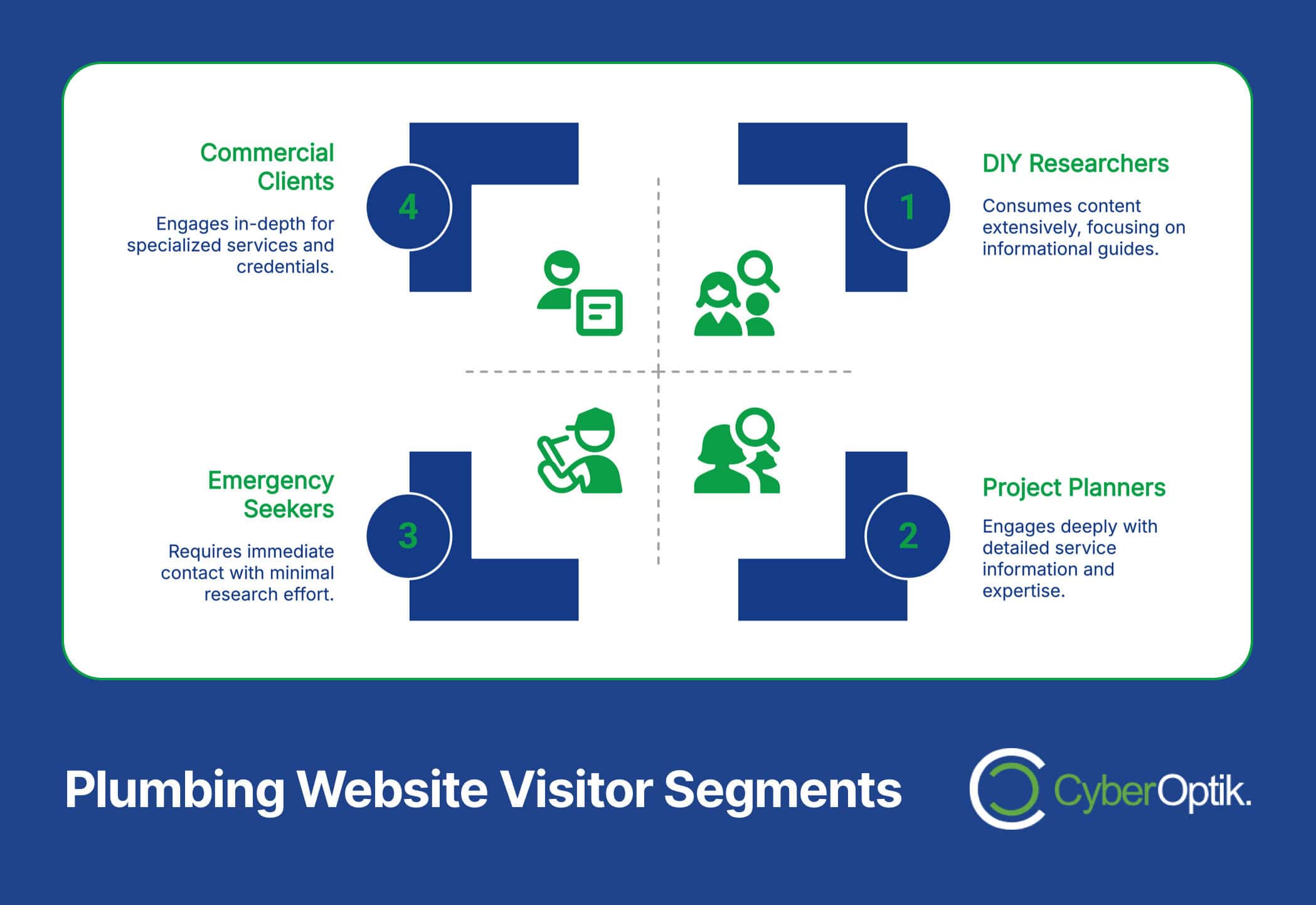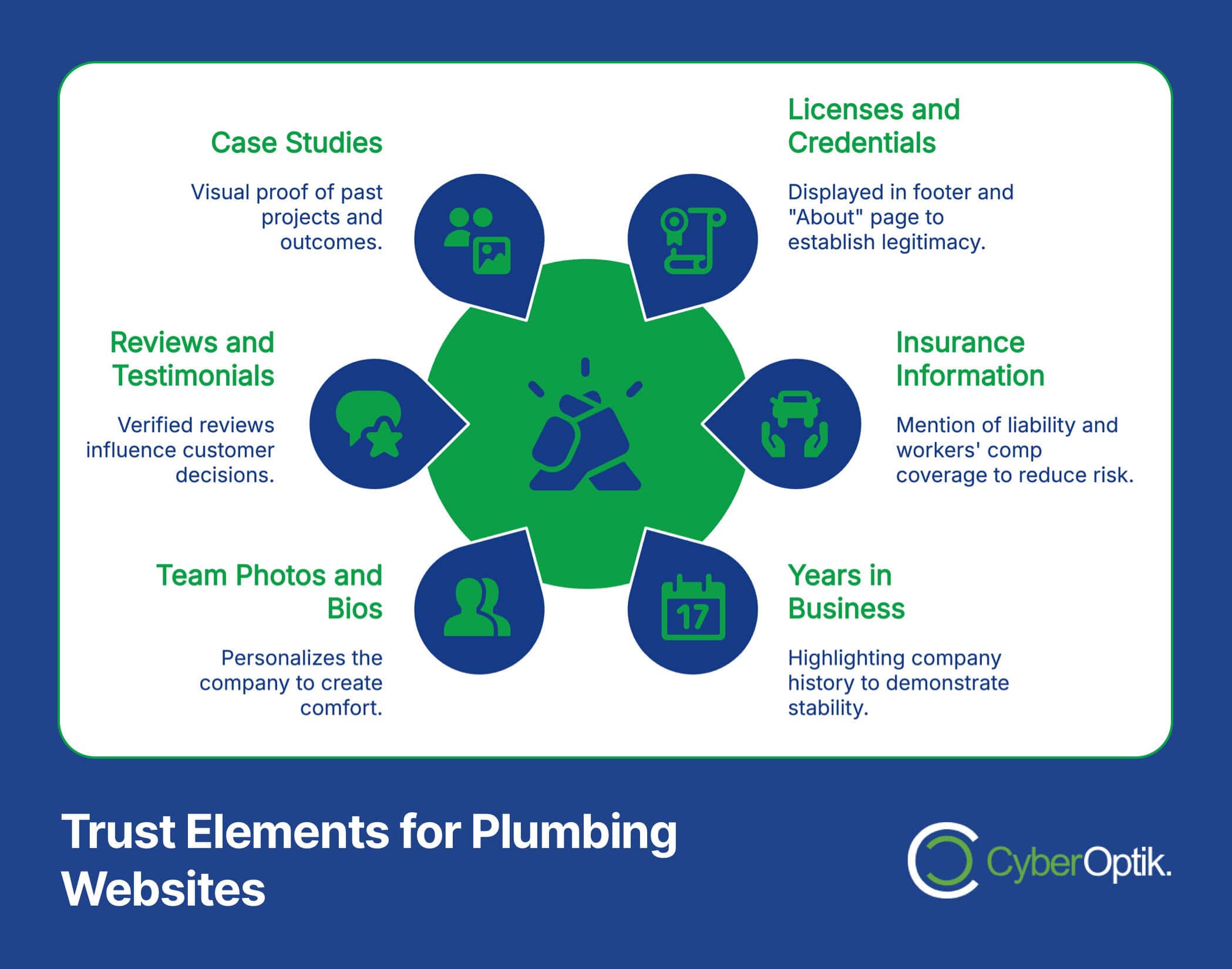The plumbing industry represents a significant sector in the American economy. The US plumbing market is valued at $158.6 billion with over 132,000 active businesses competing for customers. (Source: Getjobber) With this level of competition, having just any website isn’t enough anymore.
Plumbing companies need websites specifically designed to engage visitors and convert them into customers. The digital landscape for plumbing services has unique challenges and opportunities. Most potential customers are searching during urgent situations or conducting research for planned projects.
In our work developing websites for home service businesses, we’ve found that plumbing companies face different online challenges than other industries. Their websites must balance emergency responsiveness with comprehensive service information while building trust quickly.
This guide covers the essential elements of effective plumbing website design. We’ll explore understanding your audience, mobile optimization, conversion elements, trust-building features, technical considerations, and performance measurement. Each section provides actionable insights based on industry data and best practices.
Understanding the Plumbing Website Audience
Before designing a plumbing website, you need to understand who’s visiting and what they need. Plumbing website visitors typically fall into two main categories: emergency seekers and project planners. Each has different needs and behaviors online.

Emergency seekers need immediate contact information and quick reassurance of availability. They’re often stressed and using mobile devices to find help quickly. Project planners are researching options, comparing services, and looking for expertise and transparent pricing.
The user journey differs significantly between these groups. Emergency seekers may spend less than a minute on your site before deciding, while project planners might return multiple times before converting. Your website design must accommodate both journeys effectively.
Let’s examine the different types of visitors to plumbing websites and their specific needs:
| Customer Type | Primary Needs | Behavior Pattern | Key Website Elements |
|---|---|---|---|
| Emergency Seekers | Immediate contact, fast response | Quick scanning, minimal research | Prominent phone number, chat, emergency services highlighted |
| Project Planners | Service details, pricing, expertise | Multiple page views, return visits | Detailed service descriptions, galleries, testimonials |
| DIY Researchers | Information, guides, product details | Content consumption, blog reading | How-to content, blog, product information |
| Commercial Clients | Credentials, capacity, specialized services | In-depth research, contact for quotes | Commercial-specific pages, case studies, certifications |
Understanding these audience segments helps you prioritize design elements and create content that speaks directly to each visitor’s needs. When designing plumbing websites, creating distinctive paths for these different user types significantly improves overall engagement and conversion rates. (Source: ServiceTitan)
Essential Design Elements for Plumbing Websites
Effective plumbing websites share certain core design elements that help them engage visitors and drive conversions. These elements create a functional framework that serves both user needs and business goals.
Clear navigation stands as the foundation of any successful plumbing website. Users must find what they need quickly, especially in emergency situations. We recommend using straightforward menu items like “Emergency Services,” “Residential Plumbing,” “Commercial Plumbing,” and “Contact” as primary navigation options.
Service pages should include comprehensive information while remaining scannable. Each service deserves its own dedicated page with specific details, benefits, and relevant images. According to industry research, plumbing websites with well-organized, dedicated service pages see up to 25% higher inquiry rates than those with generalized service listings. (Source: Field Complete)
Location information must be prominent throughout the site. Local customers need to confirm you serve their area before proceeding further. Include your service area in the header or footer of every page and create location-specific pages for multi-area businesses.
Here are the must-have features every plumbing website should include:
- Prominent emergency contact information – Phone number in the header that sticks to the top of the screen while scrolling
- Clear service area information – Map or list of neighborhoods/cities served
- Mobile-responsive design – Site functions perfectly on smartphones and tablets
- Before/after photos – Visual proof of quality workmanship
- Customer testimonials – Reviews from verified customers to build trust
The visual design should convey professionalism while being approachable. Blue tones often work well for plumbing websites as they suggest water, cleanliness, and reliability. Avoid cluttered layouts that make information hard to find.
Professional imagery makes a significant difference in conversion rates. Use high-quality photos of your actual team and work rather than generic stock photography. This authenticity helps build trust with potential customers who want to know exactly who will be entering their homes.
Mobile-First Design for Plumbing Websites
Mobile optimization is no longer optional for plumbing websites—it’s essential. Data shows that 64% of US plumbing-related searches occur on mobile devices, making mobile users your primary audience. (Source: WebFX) These users have specific needs and behaviors that your website must accommodate.
Emergency plumbing situations often prompt mobile searches. Someone with a burst pipe or overflowing toilet reaches for their smartphone first. Your mobile design must make it extremely easy to contact you immediately from any page.
Mobile-first design means developing for smartphones first, then scaling up to larger screens. This approach ensures the core functionality works perfectly on small screens where most of your visitors are coming from.
Touch-friendly elements are crucial for mobile users. Buttons should be large enough to tap easily (at least 44×44 pixels), and phone numbers should be click-to-call enabled. Navigation menus need to be simple and accessible with minimal tapping.
Let’s compare key design considerations for mobile versus desktop users:
| Design Element | Mobile Optimization | Desktop Optimization | Priority Level |
|---|---|---|---|
| Contact Button | Floating button that stays visible while scrolling | Prominent in header and sidebar | Highest |
| Navigation | Simplified menu with hamburger icon | Expanded horizontal menu with dropdowns | High |
| Service Information | Concise, expandable sections | More detailed with sidebar navigation | Medium |
| Images | Fewer, optimized for faster loading | Larger gallery displays | Medium |
| Forms | Minimal fields, large input areas | Can include more fields and information | High |
Page speed becomes even more critical on mobile devices where connections may be slower. Research indicates that conversion rates increase by 74% when load time improves from 8 seconds to 2 seconds. (Source: Service Direct) Optimize images, minimize code, and utilize caching to improve mobile loading speeds.
Maintaining design consistency across device types while optimizing for each platform’s strengths represents one of the biggest challenges in responsive design. Analytics data should drive these decisions by showing you exactly how your specific audience interacts with your site on different devices. (Source: TurnCage)
Conversion-Focused Elements for Plumbing Websites
The average conversion rate for plumbing websites ranges from 2-4%, but top-performing sites consistently achieve higher numbers. (Source: Valorous Circle) The difference often comes down to strategic conversion elements placed throughout the site.
Calls-to-action (CTAs) serve as the primary conversion tools on plumbing websites. Their design, placement, and wording significantly impact effectiveness. Testing shows that red CTA buttons outperform other colors in conversion tests for emergency service businesses. (Source: Plumbing Webmasters) The color creates urgency and stands out visually on most page designs.
Contact forms should balance completeness with simplicity. Every additional field reduces completion rates, but you need enough information to qualify leads. Research indicates that reducing form fields from 11 to 4 can increase form conversions by over 120% for service businesses, though the quality of leads may vary. (Source: SHMAI)
Multiple contact options cater to different user preferences. Some customers prefer calling, while others want to request service online. Offering phone, form, chat, and email options maximizes your conversion opportunities.
Effective places to position CTAs on plumbing websites include:
- Header area – Persistent phone number and “Emergency Service” button
- End of service descriptions – After explaining the service, prompt action
- Sidebar – Contact form or call button that stays visible while scrolling
- Footer – Complete contact information and form
- Exit-intent popup – For special offers or emergency service reminder
CTA messaging should match the customer’s level of urgency and decision stage. Compare these approaches based on button color and conversion effectiveness:
| CTA Color | Message Example | Best For | Relative Conversion Rate |
|---|---|---|---|
| Red | "Emergency Service Now" | Urgent situations | Highest (+15-20%) |
| Blue | "Schedule Service" | Planned maintenance | High (+5-10%) |
| Green | "Get Free Estimate" | Project planning | Medium (baseline) |
| Orange | "Save With Special Offer" | Promotions | Medium-High (+5-15%) |
| Gray | "Learn More" | Information seekers | Low (-10-15%) |
Clear value propositions make your services compelling. Highlight benefits like 24/7 availability, licensed technicians, free estimates, or guarantees. These differentiators should appear near CTAs to reinforce the decision to contact you.
Conversion data from successful plumbing websites indicates that implementing at least three distinct call-to-action types can increase overall conversion rates by up to 30%, with each contact method appealing to different customer preferences and urgency levels. (Source: Plumber SEO)
Building Trust Through Design
Trust directly impacts conversion rates for plumbing websites. Research shows that 86% of customers verify online reviews before selecting plumbing services. (Source: Blackstorm Design) Incorporating trust elements throughout your website design is essential for converting visitors to customers.

Reviews and testimonials provide social proof that your services are reliable. Display aggregate ratings prominently and feature detailed testimonials that address common customer concerns. Third-party verification from platforms like Google or Yelp carries more weight than testimonials you select yourself.
Credentials and licensing information establish authority and legitimacy. Clearly display license numbers, insurance information, and any special certifications. Many customers specifically look for these details before hiring a plumber, especially for major projects.
Awards, affiliations, and guarantees further strengthen trust. Industry awards, membership in professional organizations, and strong guarantees (like satisfaction guarantees or free return visits) all reduce perceived risk for customers making a decision.
Essential trust elements for plumbing websites include:
- License numbers and credentials – Displayed in the footer and on an “About” page
- Insurance information – Mention of liability and workers’ comp coverage
- Years in business – Highlighting company history and experience
- Team photos and bios – Putting faces to the company name
- Service guarantees – Clearly stated satisfaction or performance guarantees
Team photos and information humanize your business. Customers want to know who will be entering their homes. Including photos, brief bios, and specialties of key team members creates connection and comfort.
Case studies or project galleries demonstrate your expertise. Before and after photos of completed work provide visual proof of quality. Include brief descriptions of the problem, solution, and outcome for each project.
Studies examining plumbing websites that fail to convert leads reveal that a lack of trust elements is the primary reason visitors leave without contacting the business, with 67% of potential customers citing missing credentials or limited social proof as their main hesitation. (Source: Mammoth for Plumbers)
Technical Optimization for Plumbing Websites
Technical optimization directly impacts both user experience and search visibility for plumbing websites. These behind-the-scenes elements play a crucial role in conversion rates and business growth.
Page loading speed significantly influences visitor behavior. When load time increases from 1 second to 3 seconds, the bounce rate increases by 32%. Plumbing websites must prioritize speed optimization to retain potential customers, especially those in emergency situations.
SSL security is no longer optional for business websites. Studies show that websites with SSL certificates (https://) have significantly higher form submission rates and user trust compared to non-secure sites. (Source: Plumbing Webmasters) The security indicator in browsers reassures visitors that their information is protected.
Local SEO elements are essential for plumbing businesses targeting specific service areas. This includes consistent NAP (Name, Address, Phone) information across the web, location-specific content, and proper Google Business Profile optimization. Research shows that 42% of local queries result in map pack clicks, making local optimization crucial for visibility. (Source: Plumbing Webmasters)
The following table shows how technical factors directly impact conversion rates:
| Technical Factor | Impact on User Experience | Impact on Conversions | Implementation Difficulty |
|---|---|---|---|
| Page Speed | Immediate - users abandon slow sites | 74% increase when improving from 8s to 2s | Medium |
| Mobile Responsiveness | Critical for 64% of traffic | 30-50% increase in mobile conversions | Medium-High |
| SSL Security | Builds trust and confidence | 10-30% increase in form submissions | Low |
| Schema Markup | Improves search visibility | 15-25% increase in click-through rates | Medium |
| Site Structure | Easier navigation and information finding | 10-20% reduction in bounce rates | Medium |
Schema markup helps search engines understand your content better. For plumbing websites, implementing LocalBusiness, Service, and Review schemas can improve how your site appears in search results. This structured data helps generate rich snippets that stand out and provide useful information directly in search results.
Proper website structure goes beyond simple navigation. A well-structured site with logical page hierarchy, breadcrumb navigation, and consistent internal linking helps both users and search engines understand your content. Analysis of high-performing plumbing websites reveals that those with carefully planned information architecture show 32% lower bounce rates than sites with confusing structures. (Source: Aspire Internet Design)
Image optimization balances quality with loading speed. Large, uncompressed images dramatically slow down websites, especially on mobile connections. Properly sized, compressed images with descriptive alt text improve both user experience and search visibility.
Measuring and Improving Website Performance
Effective measurement is essential for continuous improvement of plumbing websites. Without proper tracking, you can’t identify problems or opportunities for higher conversion rates.
Setting up Google Analytics provides the foundation for performance measurement. Configure it to track not just visits but meaningful conversion actions like form submissions, phone calls, and chat initiations. Create specific goals for each conversion type to measure success.
The most important metrics for plumbing websites focus on user behavior and conversions. Track bounce rate, time on site, pages per session, and conversion rate by traffic source. These metrics reveal how effectively your website engages visitors and turns them into leads.
Plumbing search ads have a 15.61% average conversion rate, the highest among home services industries. (Source: LocalIQ) This benchmark helps evaluate your paid traffic performance against industry standards.
Essential metrics every plumbing website should track include:
- Conversion rate by source – How different traffic channels perform
- Cost per lead/acquisition – Efficiency of marketing spend
- Mobile vs. desktop conversion rates – Effectiveness across devices
- Landing page performance – Which pages convert best
- Local search visibility – Rankings for geo-targeted keywords
A/B testing provides data-driven optimization. Test one element at a time to determine what improves conversion rates. Common elements to test include CTA button colors, form length, headline variations, and image types. Document each test with clear hypotheses and results.
Analysis of conversion-optimized plumbing websites shows that implementing a structured testing program typically yields incremental improvements of 5-10% per quarter, with the most significant gains coming from testing form layouts, call-to-action placement, and trust element positioning. (Source: Podium)
Industry data suggests that plumbing companies who track specific phone metrics like call duration, conversation outcomes, and peak call times can increase their booked appointment rates by up to 27% by adjusting staffing and website call prompts based on these insights. (Source: Triton Commerce)
Implementation Timeline and Next Steps
Creating an effective plumbing website requires thoughtful planning and implementation. The elements discussed in this guide work together to create a cohesive user experience that drives engagement and conversions.
Prioritize your implementation based on impact and resources. Mobile optimization and clear contact options should come first, followed by trust elements and conversion optimization. Technical improvements can be implemented gradually as part of ongoing maintenance.
If you’re redesigning an existing site, focus on preserving current search rankings while improving user experience. A phased approach with proper redirects and content preservation helps maintain visibility during transitions.
Market analysis shows that plumbing companies implementing comprehensive website redesigns with conversion focus typically see return on investment within 3-6 months, with conversion improvements continuing to grow over 12-18 months as optimization continues. (Source: Plumber SEO)
Industry statistics provide compelling evidence for website investment, with the most successful plumbing businesses allocating 7-10% of revenue to digital marketing channels, and websites serving as the central hub for all marketing efforts. (Source: Valve+Meter)
Here’s a quick implementation checklist to get started:
- Audit current website performance (if applicable)
- Define primary conversion goals and metrics
- Create mobile-first design mockups
- Develop content strategy with clear service descriptions
- Implement and test contact forms and CTAs
Remember that website optimization is an ongoing process, not a one-time project. Regular monitoring, testing, and improvement keep your plumbing website performing at its best and ahead of competitors.
At CyberOptik, we specialize in creating high-performing websites for home service businesses like plumbing companies. Our approach combines industry-specific design expertise with proven conversion optimization strategies that drive measurable results for our clients.




